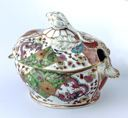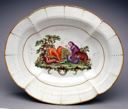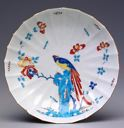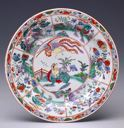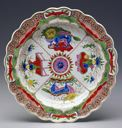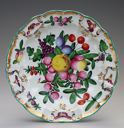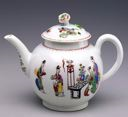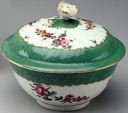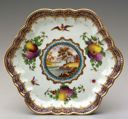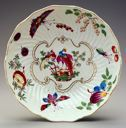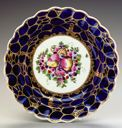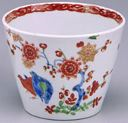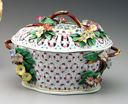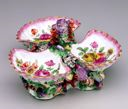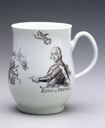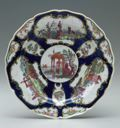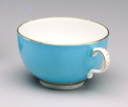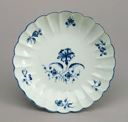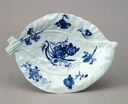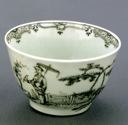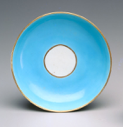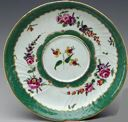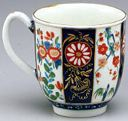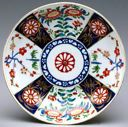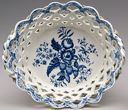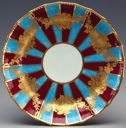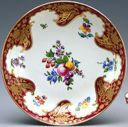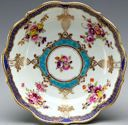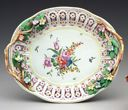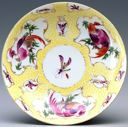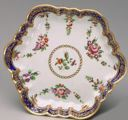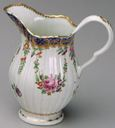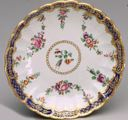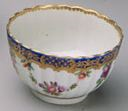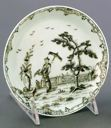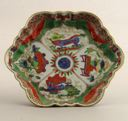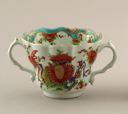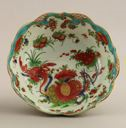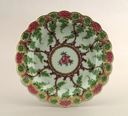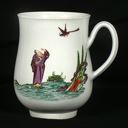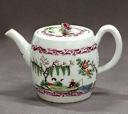Worcester Porcelain Factory
English
(established 1751 - )
Porcelain today is generally considered an article of utility, mass-produced in factories and formed and decorated by mechanical means. During the early period of its origins, however, porcelain was made and decorated by hand, and was so highly prized that owning it reflected social standing.
"The name of Worcester is synonymous with fine porcelain", writes Stanley Fischer. 1 This renowned English porcelain manufacturer, which came into existence on June 4, 1751, has stood the test of time and continues to produce fine porcelain wares to this day. They are known for their excellent quality in design, potting, and glazing and for their wide variety of styles, including Oriental, Continental, and English according to period. While they have been patronized by royalty ever since their early years, they also have always been concerned with making fine affordable wares for the general public. The history of Worcester can be divided into four periods based on new acquisitions and the transfer of various partnerships.
The first period, known as the 'Dr. Wall Period' or 'First Period', began with the founding of the company in 1751 and lasted until the acting manager, William Davis, sold the company in 1783. 2 It was founded by fifteen gentlemen, fourteen of whom were residents of Worcester, the best known being Dr. John Wall, William Davis, and the brothers Richard and Josiah Holdship. Possessing little knowledge of porcelain making themselves, they purchased in the next year the Bristol Porcelain Factory, which had been started by William Miller and Benjamin Lund in 1749. At this time the factory was moved from Bristol to Worcester.
With the purchase of this factory they acquired experienced workmen and the secrets of porcelain making. The soft-paste used to make the Bristol, and now the Worcester, porcelain contained soapstone (steatite) instead of the feldspathic rock used on the Continent. The soapstone allowed for thinner and more durable wares, and the ingredients for this paste remained the same throughout the period. The factories' success over Chelsea and Bow during this period, was largely due to the durability and plasticity of their porcelain. The early pieces of this period have a green translucency while the later pieces exhibit a creamy pale yellow color. The glaze is thin and clear and is never crazed.
Like the other porcelain factories operating at this time, many of the shapes created at Worcester were derived from silver forms. Other typical Worcester shapes include globular teapots with flower-knobbed covers, ovoid 'sparrow-beak' jugs with curving loop handles, masked-lipped 'cabbage-leaf' molded jugs, pickle trays shaped as ivy leaves and scallop shells, Chinese-shaped bowls and vases, fluted bowls, and four-lobed cups unique to Worcester. Around 1760 their shapes became more standardized as they began imitating popular Continental shapes, such as Meissen's ogee form and squat cups with everted lips.
Most of the pieces produced in the first period were table wares including salad bowls, cress dishes, creamboats, sauceboats, egg-cups, mustard-pots, ladles and spoons, knife handles, egg drainers, patty-pans, and funnels. Dessert wares included cornucopias, trellis-sided openwork baskets, and shell centerpieces. Only a limited number of decorative pieces were produced such as armorials and figurines. The factory specialized in tea-table wares and decorative vases.
Pertaining to these early period pieces, where decoration is concerned, Fischer applauds Worcester when he writes, the "decoration is comparatively reticent, seldom overcrowded so as to detract from the pure beauty of the paste, and always well placed, while at the same time often surprising the modern eye by the juxtaposition of seemingly clashing colors which yet seem to blend quite harmoniously." 3 All English factories, including Worcester, looked elsewhere for styles of decoration. The factory produced many Oriental inspired pieces. Some of the favorite patterns are the 'famille rose' sprays, Chinese ladies, known as Long Elizas, in gardens, Chinese symbols, and the Chinese stag hunt. Japanese Kakiemon designs were also prevalent, a popular one being the design of a long tailed bird perched on a rock. During the 1760's, Worcester began creating patterns of flowers in Meissen's 'indianische Blumen' style, which were superseded by Sèvres styles in the late 1760's, such as the well-known 'Cornflower' pattern and festooned wreaths across shaped panels. From 1760 to 1775, many of the Meissen and Sèvres style pieces were decorated at the atelier of James Giles in London.
Worcester's famous blue grounds appeared around 1765, adding to the already existing colors of powder-blue and yellow. By 1769 other colors included several shades of green, purple, and scarlet. Scale patterns, gold stripes, and shagreen were worked on some of these grounds. With the closing of the Chelsea factory in 1768, Worcester acquired several of their workmen. They brought with them rich ground colors, elaborate gilding, and colorful paintings of flowers, birds, figures, and landscapes.
The final years of this 'Dr. Wall Period' marked a change in decorative style to the Neo-Classical. In the beginning, most decoration was applied in underglaze blue or enamel colors, but from 1757, transfer printing began to be employed, at first in overglaze black, and by 1760 also underglaze in blue. Marks on Worcester porcelain are rare before 1760. However, they were used before this date and include, a crescent either open or shaded, a fretted square, a W in script, Meissen crossed swords with usually a 6 or 9 between the points, and usually found on pieces derived from Meissen and decorated at Gile's atelier, various sets of pseudo-Chinese characters, and tiny symbols, numerals, and letters, usually in underglaze blue, known as 'workmen's marks'.
The second phase can be classified as the Flight and Chamberlain period, which spanned from 1783 to 1850. In 1783, Thomas Flight bought the factory for his sons John and Joseph. By this time there was more competition among English potteries, partly due to Josiah Wedgwood's unrelenting quest for excellence in his wares, the invention of more and more native English decorating styles, and the public's changing tastes from Rococo to Neo-Classical. With the change over to Flight, a more severe style influenced by the Neo-Classical movement was adopted for both forms and decoration, although many of the previous forms survived this transformation. In 1786 the company's first retail shop opened in Worcester. With the success of this shop, another was opened in London in 1788. Flight's porcelain was collected for the fine painting rather than the paste.
In 1792, a partnership was formed between Joseph Flight and Martin Barr. To make production more economical, Barr began experimenting with the paste, and by 1795 he had developed a mixture that produced more opaque, whiter, and harder bodies. With this change came a new style of decoration: landscape painting, made popular by the late eighteenth and early nineteenth century landscape artists, such as William Turner and John Constable. In 1804, Martin Barr, Junior joined the company, which then changed its name from Flight & Barr to Barr, Flight & Barr and finally to Flight, Barr & Barr in 1813. Throughout the early nineteenth century, the factory continued to make their excellent tea services with abundant fluting and tasteful decoration. They also produced many wares showing naturalistic motifs, such as shells and feathers, and continued to make Neo-Classical pieces in addition to the revival of chinoiserie and japonaiserie designs.
In 1840, because of the competition from the bone china manufacturer of Staffordshire, Robert Chamberlain's company merged with the weakening one of Flight, Barr & Barr. Chamberlain had been an apprentice to Dr. Wall but left after the buyout in 1783 to set up his own factory, which was established around 1786. The new company, known as Chamberlain & Company, left their original workshops in 1847 and moved into Chamberlain's facilities in London, which is the site of the present day factory.
Like Flight's porcelain, Chamberlain's Worcester is not revered for its paste, but for its exquisite decoration. Though Chamberlain & Company continued many of the same forms and decorations, such as scale patterns with flowers or exotic birds, and Japanese patterns, the overall decoration was more conservative than Flight and Barr's. The pieces during this second period are clearly marked using the names or initials of Flight, Barr, and Barr in various combinations depending on which date the piece may have been produced, i.e. during which partnership it may fall. Chamberlain's Worcester is marked with the company name and usually the address.
The third phase, known as the 'Kerr and Binns Period', lasted only ten years from 1851 to 1861. Kerr acted as the businessman and Binns as the artistic director. Together they set out to "revive the somewhat faded glories of the Worcester porcelain." 4 They hired new artists and kept some of the old ones. Kirk, one of the new artists and son of a famous Irish sculptor, designed a twenty-four person dessert service known as the 'Shakespeare Service'. The service consisted of Parian ware groups of figures from A Midsummer Night's Dream and porcelain plates, tureens, etc. decorated with Renaissance motifs. The fine design and technical perfection set the company back on its feet and into the forefront of porcelain manufacturing. Noblemen and gentry often lent art works to serve as models for ornamental wares. Specialties of the company were the production of 'Limoges ware' porcelain decorated in white enamel on a dark-blue ground and George Owen's pierced or 'reticulated' ware. These pieces, along with elaborate and lavishly gilded and painted Victorian pieces, ivory-toned Parian ware statuettes, and charming groups of children in the style of Kate Greenway, continued to be produced into the final phase of the company.
This final phase, starting in 1862, marks the beginning of the modern company. It was established with the founding of the joint stock company which is still known as the Worcester Royal Porcelain Company Limited. The company began placing more and more emphasis on decoration. Outstanding ground colors and rich gilding were applied to the white porcelain bodies, however, the ivory body was more popular because it enhanced enameling. Foreign styles were applied to the ivory bodies, especially styles derived from Japanese art which was 'en vogue' during the 1860s, 70s, and 80s. These pieces contain low relief work and panels of various tints of bronze, silver, and dusted gold, with scaled dragons and dainty piercing. Pieces were also decorated in the Persian, Florentine, Italian, and Louis XVI manner. However, the majority of late nineteenth century and early twentieth century wares were decorated with rich bunches of flowers on a cream or light-green ground.
Twentieth century wares show Highland cattle, pheasants, swans, and fruit and flowers, usually with elaborate gilding. During this century, there have been revivals of early Worcester styles. In 1935, the company began producing the well-known Doughty birds modeled by Dorothy Doughty, and since 1947 has offered the equestrian figures of Doris Lindner, known as the Lindner horses. The company continues to produce outstanding porcelain products.
Footnotes:
1. Stanley Fishcher, Worcester Porcelain, (London: Warlock and Company, Ltd.) p. 51.
2. Recent texts no longer use the designation "Dr. Wall Period" since other men besides Dr. Wall, such as William Davis, are now known to have played a major role in the company's success during this period.
3. Fischer, p. 6.
4. Fischer, p. 22.
English
(established 1751 - )
Porcelain today is generally considered an article of utility, mass-produced in factories and formed and decorated by mechanical means. During the early period of its origins, however, porcelain was made and decorated by hand, and was so highly prized that owning it reflected social standing.
"The name of Worcester is synonymous with fine porcelain", writes Stanley Fischer. 1 This renowned English porcelain manufacturer, which came into existence on June 4, 1751, has stood the test of time and continues to produce fine porcelain wares to this day. They are known for their excellent quality in design, potting, and glazing and for their wide variety of styles, including Oriental, Continental, and English according to period. While they have been patronized by royalty ever since their early years, they also have always been concerned with making fine affordable wares for the general public. The history of Worcester can be divided into four periods based on new acquisitions and the transfer of various partnerships.
The first period, known as the 'Dr. Wall Period' or 'First Period', began with the founding of the company in 1751 and lasted until the acting manager, William Davis, sold the company in 1783. 2 It was founded by fifteen gentlemen, fourteen of whom were residents of Worcester, the best known being Dr. John Wall, William Davis, and the brothers Richard and Josiah Holdship. Possessing little knowledge of porcelain making themselves, they purchased in the next year the Bristol Porcelain Factory, which had been started by William Miller and Benjamin Lund in 1749. At this time the factory was moved from Bristol to Worcester.
With the purchase of this factory they acquired experienced workmen and the secrets of porcelain making. The soft-paste used to make the Bristol, and now the Worcester, porcelain contained soapstone (steatite) instead of the feldspathic rock used on the Continent. The soapstone allowed for thinner and more durable wares, and the ingredients for this paste remained the same throughout the period. The factories' success over Chelsea and Bow during this period, was largely due to the durability and plasticity of their porcelain. The early pieces of this period have a green translucency while the later pieces exhibit a creamy pale yellow color. The glaze is thin and clear and is never crazed.
Like the other porcelain factories operating at this time, many of the shapes created at Worcester were derived from silver forms. Other typical Worcester shapes include globular teapots with flower-knobbed covers, ovoid 'sparrow-beak' jugs with curving loop handles, masked-lipped 'cabbage-leaf' molded jugs, pickle trays shaped as ivy leaves and scallop shells, Chinese-shaped bowls and vases, fluted bowls, and four-lobed cups unique to Worcester. Around 1760 their shapes became more standardized as they began imitating popular Continental shapes, such as Meissen's ogee form and squat cups with everted lips.
Most of the pieces produced in the first period were table wares including salad bowls, cress dishes, creamboats, sauceboats, egg-cups, mustard-pots, ladles and spoons, knife handles, egg drainers, patty-pans, and funnels. Dessert wares included cornucopias, trellis-sided openwork baskets, and shell centerpieces. Only a limited number of decorative pieces were produced such as armorials and figurines. The factory specialized in tea-table wares and decorative vases.
Pertaining to these early period pieces, where decoration is concerned, Fischer applauds Worcester when he writes, the "decoration is comparatively reticent, seldom overcrowded so as to detract from the pure beauty of the paste, and always well placed, while at the same time often surprising the modern eye by the juxtaposition of seemingly clashing colors which yet seem to blend quite harmoniously." 3 All English factories, including Worcester, looked elsewhere for styles of decoration. The factory produced many Oriental inspired pieces. Some of the favorite patterns are the 'famille rose' sprays, Chinese ladies, known as Long Elizas, in gardens, Chinese symbols, and the Chinese stag hunt. Japanese Kakiemon designs were also prevalent, a popular one being the design of a long tailed bird perched on a rock. During the 1760's, Worcester began creating patterns of flowers in Meissen's 'indianische Blumen' style, which were superseded by Sèvres styles in the late 1760's, such as the well-known 'Cornflower' pattern and festooned wreaths across shaped panels. From 1760 to 1775, many of the Meissen and Sèvres style pieces were decorated at the atelier of James Giles in London.
Worcester's famous blue grounds appeared around 1765, adding to the already existing colors of powder-blue and yellow. By 1769 other colors included several shades of green, purple, and scarlet. Scale patterns, gold stripes, and shagreen were worked on some of these grounds. With the closing of the Chelsea factory in 1768, Worcester acquired several of their workmen. They brought with them rich ground colors, elaborate gilding, and colorful paintings of flowers, birds, figures, and landscapes.
The final years of this 'Dr. Wall Period' marked a change in decorative style to the Neo-Classical. In the beginning, most decoration was applied in underglaze blue or enamel colors, but from 1757, transfer printing began to be employed, at first in overglaze black, and by 1760 also underglaze in blue. Marks on Worcester porcelain are rare before 1760. However, they were used before this date and include, a crescent either open or shaded, a fretted square, a W in script, Meissen crossed swords with usually a 6 or 9 between the points, and usually found on pieces derived from Meissen and decorated at Gile's atelier, various sets of pseudo-Chinese characters, and tiny symbols, numerals, and letters, usually in underglaze blue, known as 'workmen's marks'.
The second phase can be classified as the Flight and Chamberlain period, which spanned from 1783 to 1850. In 1783, Thomas Flight bought the factory for his sons John and Joseph. By this time there was more competition among English potteries, partly due to Josiah Wedgwood's unrelenting quest for excellence in his wares, the invention of more and more native English decorating styles, and the public's changing tastes from Rococo to Neo-Classical. With the change over to Flight, a more severe style influenced by the Neo-Classical movement was adopted for both forms and decoration, although many of the previous forms survived this transformation. In 1786 the company's first retail shop opened in Worcester. With the success of this shop, another was opened in London in 1788. Flight's porcelain was collected for the fine painting rather than the paste.
In 1792, a partnership was formed between Joseph Flight and Martin Barr. To make production more economical, Barr began experimenting with the paste, and by 1795 he had developed a mixture that produced more opaque, whiter, and harder bodies. With this change came a new style of decoration: landscape painting, made popular by the late eighteenth and early nineteenth century landscape artists, such as William Turner and John Constable. In 1804, Martin Barr, Junior joined the company, which then changed its name from Flight & Barr to Barr, Flight & Barr and finally to Flight, Barr & Barr in 1813. Throughout the early nineteenth century, the factory continued to make their excellent tea services with abundant fluting and tasteful decoration. They also produced many wares showing naturalistic motifs, such as shells and feathers, and continued to make Neo-Classical pieces in addition to the revival of chinoiserie and japonaiserie designs.
In 1840, because of the competition from the bone china manufacturer of Staffordshire, Robert Chamberlain's company merged with the weakening one of Flight, Barr & Barr. Chamberlain had been an apprentice to Dr. Wall but left after the buyout in 1783 to set up his own factory, which was established around 1786. The new company, known as Chamberlain & Company, left their original workshops in 1847 and moved into Chamberlain's facilities in London, which is the site of the present day factory.
Like Flight's porcelain, Chamberlain's Worcester is not revered for its paste, but for its exquisite decoration. Though Chamberlain & Company continued many of the same forms and decorations, such as scale patterns with flowers or exotic birds, and Japanese patterns, the overall decoration was more conservative than Flight and Barr's. The pieces during this second period are clearly marked using the names or initials of Flight, Barr, and Barr in various combinations depending on which date the piece may have been produced, i.e. during which partnership it may fall. Chamberlain's Worcester is marked with the company name and usually the address.
The third phase, known as the 'Kerr and Binns Period', lasted only ten years from 1851 to 1861. Kerr acted as the businessman and Binns as the artistic director. Together they set out to "revive the somewhat faded glories of the Worcester porcelain." 4 They hired new artists and kept some of the old ones. Kirk, one of the new artists and son of a famous Irish sculptor, designed a twenty-four person dessert service known as the 'Shakespeare Service'. The service consisted of Parian ware groups of figures from A Midsummer Night's Dream and porcelain plates, tureens, etc. decorated with Renaissance motifs. The fine design and technical perfection set the company back on its feet and into the forefront of porcelain manufacturing. Noblemen and gentry often lent art works to serve as models for ornamental wares. Specialties of the company were the production of 'Limoges ware' porcelain decorated in white enamel on a dark-blue ground and George Owen's pierced or 'reticulated' ware. These pieces, along with elaborate and lavishly gilded and painted Victorian pieces, ivory-toned Parian ware statuettes, and charming groups of children in the style of Kate Greenway, continued to be produced into the final phase of the company.
This final phase, starting in 1862, marks the beginning of the modern company. It was established with the founding of the joint stock company which is still known as the Worcester Royal Porcelain Company Limited. The company began placing more and more emphasis on decoration. Outstanding ground colors and rich gilding were applied to the white porcelain bodies, however, the ivory body was more popular because it enhanced enameling. Foreign styles were applied to the ivory bodies, especially styles derived from Japanese art which was 'en vogue' during the 1860s, 70s, and 80s. These pieces contain low relief work and panels of various tints of bronze, silver, and dusted gold, with scaled dragons and dainty piercing. Pieces were also decorated in the Persian, Florentine, Italian, and Louis XVI manner. However, the majority of late nineteenth century and early twentieth century wares were decorated with rich bunches of flowers on a cream or light-green ground.
Twentieth century wares show Highland cattle, pheasants, swans, and fruit and flowers, usually with elaborate gilding. During this century, there have been revivals of early Worcester styles. In 1935, the company began producing the well-known Doughty birds modeled by Dorothy Doughty, and since 1947 has offered the equestrian figures of Doris Lindner, known as the Lindner horses. The company continues to produce outstanding porcelain products.
Footnotes:
1. Stanley Fishcher, Worcester Porcelain, (London: Warlock and Company, Ltd.) p. 51.
2. Recent texts no longer use the designation "Dr. Wall Period" since other men besides Dr. Wall, such as William Davis, are now known to have played a major role in the company's success during this period.
3. Fischer, p. 6.
4. Fischer, p. 22.
Artist Objects
